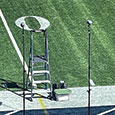Student teaching is one of the most important parts of a music education major’s studies. All of the student teachers I supervise at James Madison University must assemble a portfolio as part of their course requirement. This group of documents assists student teachers in making sure that the important components of student teaching are included in the process and that they are documented for review by prospective employers.
Student Background Assignment
Each student teacher selects two students and conducts research into the students’ permanent records to establish trends and class performance from the past. The intent is for each student teacher to investigate the students’ backgrounds with the goal of individualizing their instruction. The student teacher then writes up a one-page summary of findings along with a list of instructional strategies based on those findings.
Video Responses
Student teachers are instructed to videotape themselves teaching a class four times during the semester. These videos should be viewed, and then the student teachers should write up a short reflection on their observations. They should critique areas of strength and weakness. These videos are usually very enlightening (and humbling).
Technology Project
Each student teacher selects a project that demonstrates the use of technology to improve instruction; this can include student use of technology or teacher use of technology on the students’ behalf. This means that a student teacher could use a music notation software program to create warm-up exercises for his ensemble or use SmartMusic with students. This project can involve any of the music applicable technologies such as digital recording or various MIDI applications.
Effect on Learning Project
This item is the most likely to draw the attention of prospective employers. Each student teacher selects a concept that is new to the class. This might be teaching eighth notes for a beginning ensemble or interval studies for advanced performers. The student teacher creates a pre-test, following good principles for rubric and test construction, to find out what the students already know about the topic. This pre-test can be in the form of a written test, a sound recording of the ensemble performing or any other form of assessment that will illustrate the students’ prior knowledge. The student teacher then teaches a minimum of three lessons on the topic. More than three lessons may be needed to cover the concept, but the limited time a student teacher has with a given class may limit the number of lessons taught. A post-test is then given to see how far students have progressed in their understanding of the concept or skill.
The amount of progress the class makes on the post-test is really not as important as the process of taking students from point A to point B in a logical and efficient manner. The student teacher then must write up a summary of the project which would include several examples of differentiation and describe several possible changes which would make the lessons even more effective.
Sample Lesson Plans
Many administrators insist on detailed lesson plans with stated student outcomes and assessment tools included. The lesson plans should include learning objectives and materials needed to teach the lesson as well. These documents are intended to provide evidence that a student teacher is proficient at planning lessons, assessing students, modifying plans to improve instruction, meeting the needs of diverse learners, using technology in the classroom, and generally developing a good climate for learning. Sample lesson plans should also show evidence of reflection and growth.
Conclusion
Additional items such as practicum write-ups, repertoire lists, a performance list, and a short philosophy of music education will add even more depth to this documentation. A one-page cover letter and a resume can also be effective inclusions. The student teacher portfolio is a valuable way for a student teacher to illustrate that the best practices for teaching are forefront in their music educator training.






